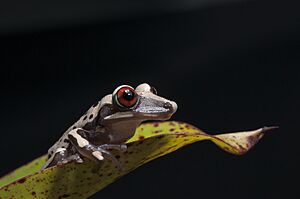Bruno's casque-headed frog facts for kids
Quick facts for kids Bruno's casque-headed frog |
|
|---|---|
 |
|
| Conservation status | |
| Scientific classification | |
| Synonyms | |
|
List
|
Bruno's casque-headed frog (Nyctimantis brunoi) is a special kind of frog that lives only in Brazil. It's known for its unique head, which looks a bit like it's wearing a helmet! This frog lives in wet, tropical forests and marshy areas. Sadly, its home is shrinking because of habitat loss.
This frog was named brunoi to honor Dr. Bruno Lobo. He was a professor and director at the National Museum of Brazil many years ago.
Contents
Meet Bruno's Casque-Headed Frog
This frog is quite large for a frog. Male frogs are usually about 4.9 to 6.2 centimeters (about 2 to 2.4 inches) long. Female frogs are a bit bigger, measuring 5.6 to 8.1 centimeters (about 2.2 to 3.2 inches).
What Does It Look Like?
Bruno's casque-headed frog has a wide, flat head with a long, pointy snout. Its eyes stick out and face forward. The most interesting part is its head, which has many sharp, pointed bumps. The skin on its head is actually stuck to its skull! This makes its head very strong and hard.
Its legs are long and thin. The tips of its toes have sticky pads, which help it climb and hold on. The frog's skin is usually light brown or gray, with dark, uneven patterns.
Where Do These Frogs Live?
Bruno's casque-headed frog is found only in the coastal areas of southeastern Brazil. Its home stretches from the state of Bahia down to the northern part of São Paulo.
Their Forest Home
These frogs live in forests and at the edges of forests. During the day, they like to hide in hollows filled with water inside trees or bamboo. They also hide in water-filled plants called bromeliads. They are very clever about choosing a hiding spot. They find a crack or crevice that is just the right size. Then, they use their hard heads to seal off the entrance, keeping themselves safe inside. They usually live at altitudes up to about 500 meters (about 1,640 feet) above sea level.
A Frog with a Special Defense
Unlike some frogs that just have poison on their skin, Bruno's casque-headed frog has a very unique way to protect itself. It has special skull spines that can inject a type of venom! If another animal or even a human tries to bother it, the frog can headbutt them. This pushes the spines into the attacker, releasing the venom. Another frog, Corythomantis greeningi, uses a similar defense.
The venom from Nyctimantis brunoi is very strong. It is much more powerful than the venom of some dangerous snakes found in the same area. This special defense helps the frog stay safe from predators.


